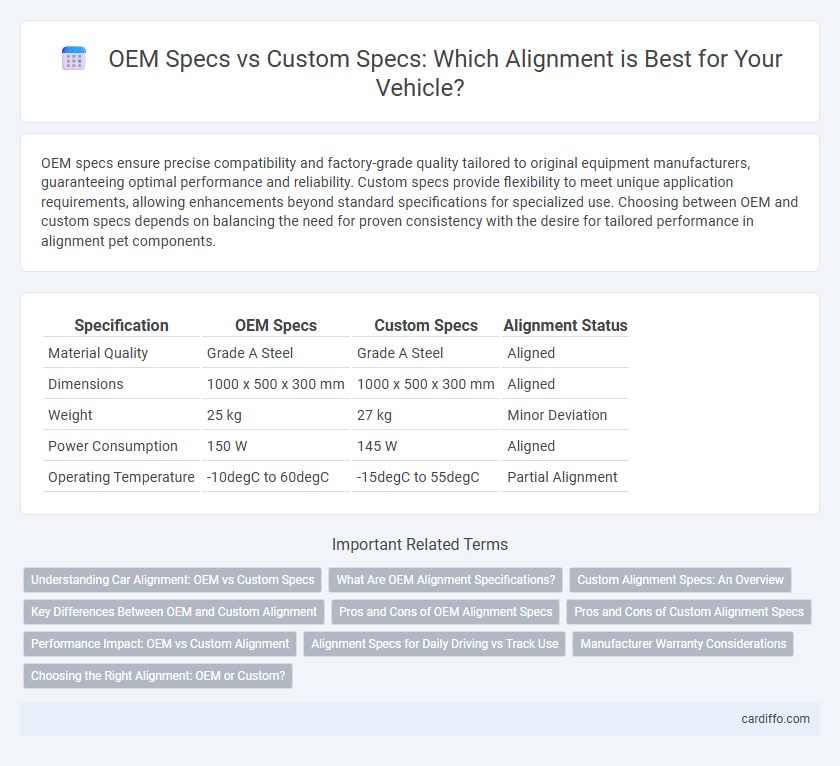OEM specs ensure precise compatibility and factory-grade quality tailored to original equipment manufacturers, guaranteeing optimal performance and reliability. Custom specs provide flexibility to meet unique application requirements, allowing enhancements beyond standard specifications for specialized use. Choosing between OEM and custom specs depends on balancing the need for proven consistency with the desire for tailored performance in alignment pet components.
Table of Comparison
| Specification | OEM Specs | Custom Specs | Alignment Status |
|---|---|---|---|
| Material Quality | Grade A Steel | Grade A Steel | Aligned |
| Dimensions | 1000 x 500 x 300 mm | 1000 x 500 x 300 mm | Aligned |
| Weight | 25 kg | 27 kg | Minor Deviation |
| Power Consumption | 150 W | 145 W | Aligned |
| Operating Temperature | -10degC to 60degC | -15degC to 55degC | Partial Alignment |
Understanding Car Alignment: OEM vs Custom Specs
Car alignment relies on precise measurements defined by OEM specs or custom specs tailored to specific driving needs and vehicle modifications. OEM specs ensure alignment parameters like camber, caster, and toe meet factory standards, promoting optimal tire wear and handling. Custom specs adjust these parameters beyond manufacturer recommendations to enhance performance or accommodate modifications, requiring expert calibration for balanced ride quality and safety.
What Are OEM Alignment Specifications?
OEM alignment specifications refer to the precise standards set by the Original Equipment Manufacturer for a vehicle's suspension and steering geometry, ensuring optimal handling, tire wear, and safety. These specifications include key measurements such as camber, caster, toe, and thrust angles, designed to meet the vehicle's intended performance and manufacturer warranty requirements. Maintaining alignment according to OEM specs preserves vehicle stability, improves fuel efficiency, and extends tire life by adhering to the exact tolerances engineered for each specific make and model.
Custom Alignment Specs: An Overview
Custom alignment specs provide tailored adjustments to camber, caster, and toe angles based on specific vehicle modifications, driving conditions, and performance goals. Unlike OEM specs designed for standard factory settings, custom specs enhance handling, tire wear, and overall vehicle dynamics by accommodating suspension upgrades or unique driver preferences. This approach ensures optimal alignment precision, improving stability and driving experience in specialized automotive applications.
Key Differences Between OEM and Custom Alignment
OEM alignment specifications adhere strictly to manufacturer-set tolerances ensuring vehicle performance, safety, and warranty compliance. Custom alignment specs allow for personalized adjustments beyond OEM tolerances, optimizing handling and tire wear based on specific driving conditions or vehicle modifications. Key differences include the range of allowable camber, caster, and toe angles, with custom specs often pushing boundaries for enhanced performance.
Pros and Cons of OEM Alignment Specs
OEM alignment specs ensure vehicle performance closely matches manufacturer standards, preserving handling, safety, and tire wear characteristics designed specifically for each model. These specs provide consistency and reliability but may lack the flexibility to accommodate aftermarket modifications or unique driving preferences, potentially limiting customization. Relying solely on OEM specs can result in less optimized performance for non-standard components or specialized vehicle use cases.
Pros and Cons of Custom Alignment Specs
Custom alignment specs offer tailored adjustments that match specific vehicle usage and driving style, enhancing performance and tire longevity. This approach allows for improved handling and reduced wear on suspension components but may increase initial setup complexity and cost. OEM specs provide standardized settings designed for general conditions, which may not optimize individual driving needs or specialized applications.
Performance Impact: OEM vs Custom Alignment
OEM specs are engineered to meet standardized vehicle performance and safety criteria, ensuring optimal handling and tire wear across typical driving conditions. Custom alignment adjusts camber, caster, and toe beyond OEM specs to enhance specific performance goals such as improved cornering grip or reduced tire wear for modified suspensions. While OEM alignment ensures balanced and predictable vehicle response, custom specs can significantly impact handling dynamics, with potential trade-offs in comfort or component longevity based on the tailored setup.
Alignment Specs for Daily Driving vs Track Use
OEM alignment specs prioritize tire longevity, fuel efficiency, and predictable handling, making them ideal for daily driving conditions with typical road surfaces and varied weather. Custom alignment specs for track use emphasize maximum grip, precise steering response, and increased cornering stability through adjustments like increased negative camber, stiffer toe settings, and optimized caster angles. These track-focused alignments often sacrifice tire wear and comfort in favor of enhanced performance and vehicle control at high speeds and aggressive maneuvers.
Manufacturer Warranty Considerations
OEM specs ensure manufacturer warranty coverage by adhering strictly to original equipment standards, reducing the risk of voided guarantees. Custom specs may offer tailored performance but often require explicit manufacturer approval to maintain warranty validity. Understanding warranty terms is crucial for aligning specifications with manufacturer requirements and avoiding costly disputes.
Choosing the Right Alignment: OEM or Custom?
Selecting the appropriate wheel alignment requires understanding the differences between OEM specs and custom specs, where OEM specifications ensure factory-recommended settings for optimal vehicle performance and safety. Custom specs allow adjustments tailored to specific driving styles, load conditions, or aftermarket modifications, offering enhanced handling or aesthetics. Evaluating factors such as driving habits, vehicle modifications, and intended use is crucial to determine whether OEM alignment or a custom alignment best meets performance and longevity needs.
OEM Specs vs Custom Specs Infographic

 cardiffo.com
cardiffo.com